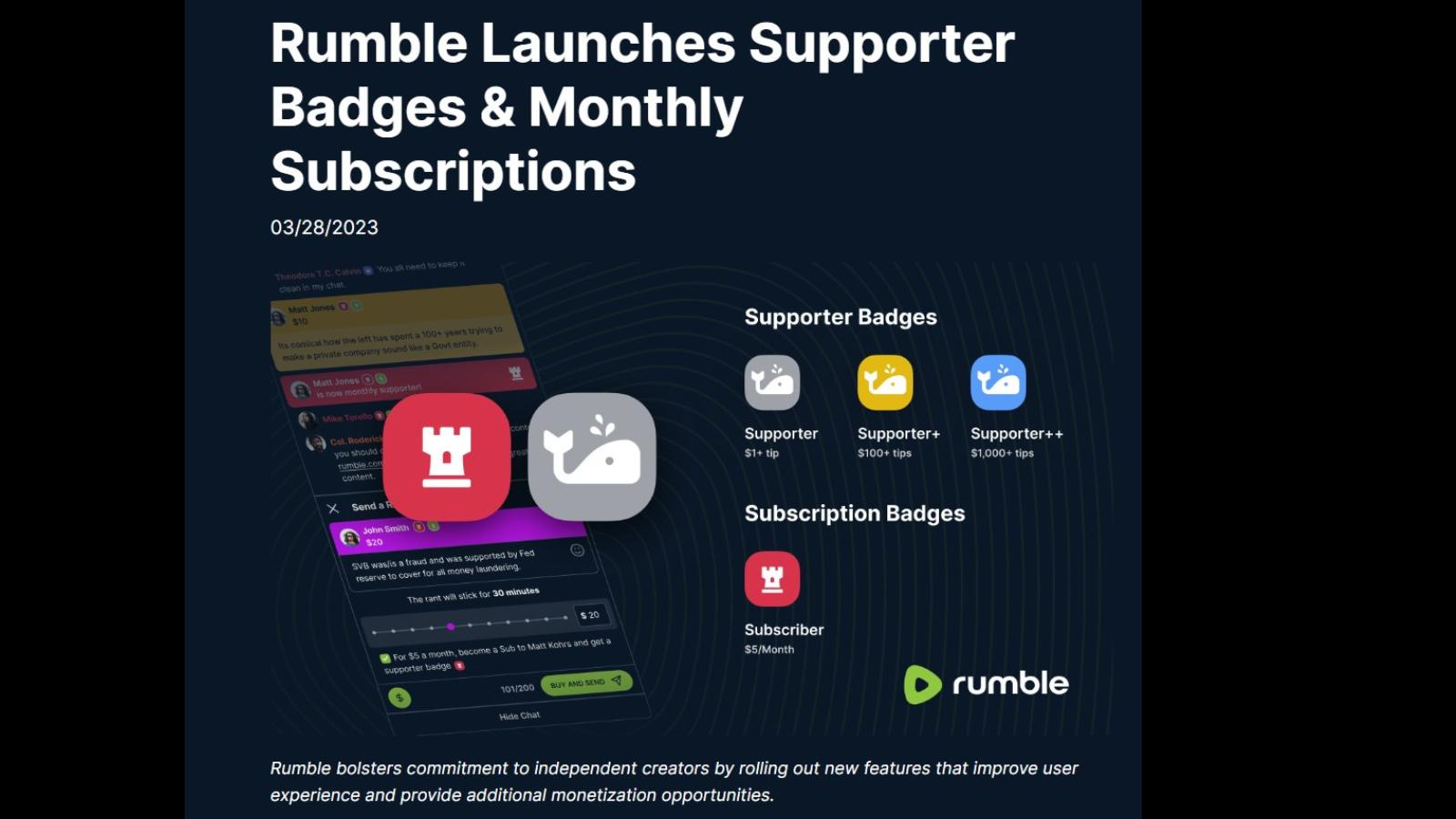Welcome to the world of Rumble, a rising star in the streaming landscape that’s taking the internet by storm! Rumble offers a platform for users to share and view video content, competing with giants like YouTube. But what sets
What is Pay Per View and How Does it Work?

Pay Per View (PPV) is an intriguing model that allows users to purchase access to specific pieces of content for a one-time fee. Unlike traditional subscription models, where you pay a flat fee for unlimited access, PPV lets you selectively pay only for what you want to watch. This model has become a significant revenue stream for platforms like Rumble.
So, how does it work? Here’s a breakdown:
- User Selection: When a viewer wants to access exclusive content—say, an event, a special documentary, or a unique performance—the platform presents the option to purchase it as PPV.
- Payment Processing: Once the viewer decides to go ahead, they complete the purchase through a secure payment gateway. Rumble facilitates this process, ensuring smooth transactions.
- Access Granted: After payment, access is granted, usually through a digital token or a link that takes the user to the content.
- Viewing Window: Typically, PPV content is available for a set period. Viewers might have 24 to 48 hours to watch the video once they buy it, encouraging immediate viewing.
The key benefits of PPV include:
- Direct Monetization: Creators get to capitalize on high-demand content without losing potential earnings to subscriptions.
- Wider Reach: Viewers who might not want to subscribe can still access quality content, increasing overall engagement.
- Flexibility: It offers viewers the freedom to pick and choose what they want to watch without the commitment of a monthly fee.
For Rumble, integrating a PPV system aligns perfectly with its overarching model of empowering creators. It allows content creators to earn money directly from their fans, fostering loyalty and encouraging more unique content production.
In summary, the Pay Per View model on Rumble is not just a financial mechanism; it’s a way of fostering a vibrant community where both creators and viewers benefit. As Rumble continues to grow, its PPV offerings are sure to evolve, making it an exciting space to keep an eye on!
Also Read This: Does Rumble Have Closed Captioning? A Look at Accessibility Features on the Rumble Platform
3. Rumble’s Approach to Revenue Generation

When it comes to generating revenue, Rumble takes a multifaceted approach. This platform isn't just playing one tune; instead, it mixes different strategies to create a symphony of income. One of the key methods they use is advertising. Just like many online platforms, Rumble makes money from ads displayed alongside videos. This means that when you’re scrolling through interesting content, you might see an ad pop up, and that’s how Rumble gets a slice of the advertising pie.
Another interesting aspect of Rumble’s revenue generation is its partnership model. Rumble allows content creators to monetize their videos directly through the platform, which is a win-win situation. Creators can earn money from their content, while Rumble earns a portion as they facilitate this arrangement. It’s like a creative collaboration where all parties involved can benefit.
Furthermore, Rumble also capitalizes on the growing trend of subscription services. They offer different tiers of subscription plans that provide various perks, such as ad-free viewing or premium access to certain exclusive content. This subscription model provides a steady stream of income, ensuring that Rumble isn’t solely reliant on ad revenue.
This diverse revenue generation strategy has positioned Rumble as a strong competitor in the crowded video-sharing market, allowing it to attract a loyal base of content creators and viewers alike. The platform’s ability to adapt and combine different monetization methods is a key factor in its sustained growth and appeal.
Also Read This: How Did Eren Start the Rumbling? The Catalyst Behind the Event
4. Does Rumble Offer Pay Per View Options?

When it comes to pay-per-view (PPV) options, Rumble is definitely in the game. But how does this work, and what can users expect? For those unfamiliar with the concept, PPV allows viewers to pay a specific fee to access a particular video or event, which can be a live-streamed match, a concert, or any other premium content. It’s a model that many platforms are leveraging to provide exclusive content while generating revenue.
Rumble has recognized the potential of PPV and has begun to roll out this feature, particularly for live events. This is great news for creators who want to monetize high-demand events while giving viewers a chance to enjoy premium content without needing a subscription. But how does it all work? Here’s a quick overview:
- Event Selection: Not all content is available for PPV; typically, it’s reserved for live events or exclusive releases that creators believe will attract significant interest.
- Payment Process: Viewers can easily purchase access through the Rumble platform, often integrated seamlessly into their viewing experience.
- Revenue Share: Rumble usually takes a percentage of the PPV revenue, while the rest goes to the content creator, incentivizing them to produce high-quality, engaging events.
The introduction of PPV options is not just about making money; it also offers audiences the chance to watch unique, unmissable events that they might not find elsewhere. For content creators, it’s a fantastic way to tap into their audience’s willingness to pay for premium experiences, thereby elevating their potential earnings.
Overall, as Rumble continues to evolve and innovate, the addition of pay-per-view options stands to enhance the platform’s offerings, making it an exciting place for both content creators and viewers alike.
Also Read This: How Can I Get Rumble on My TV? A Guide to Accessing Rumble on Your Smart Devices
5. Comparing Rumble’s Revenue Model to Other Platforms
When it comes to video sharing platforms, Rumble stands out with its unique approach to monetization. To really appreciate Rumble's revenue model, it's helpful to compare it to other popular platforms like YouTube and Vimeo.
Rumble vs. YouTube
YouTube is undoubtedly the giant in the video-sharing world. Its revenue model primarily revolves around ad monetization. Creators earn money through ads that run on their videos, which can be lucrative, especially for those who reach a large audience. However, YouTube takes a significant cut of this revenue—typically around 45%—leaving creators with 55% of ad earnings.
In contrast, Rumble offers a more creator-friendly approach. On Rumble, creators can earn up to 100% of their earnings when they upload content. This is particularly appealing to new and emerging creators who may not have established a massive following yet. Rumble also allows creators to potentially license their videos for a fee, providing an additional revenue stream that is less common on YouTube.
Rumble vs. Vimeo
Vimeo, on the other hand, caters more to professionals looking for high-quality video hosting and portfolio services. Its monetization options mainly involve subscription plans and renting or selling videos. While Vimeo offers a more tailored experience for creators, its revenue potential can be hindered by these upfront costs—especially for smaller creators who may not produce content frequently.
Rumble, on the flip side, allows anyone to monetize their content directly without the barrier of subscription fees. This opens the doors to a broader range of creators, including those who may not choose to invest in a paid platform.
Conclusion
In summary, Rumble’s revenue model is distinctively designed to empower creators with more control and higher earnings. The comparison with YouTube and Vimeo illustrates how Rumble stands apart by prioritizing the financial interests of its users. This approach could potentially reshape how independent creators monetize their work in the long run.
Also Read This: How to Create a Rumble Account and Join the Platform’s Growing Community
6. User Experience on Rumble: Benefits and Drawbacks
User experience is a vital aspect of any platform, and Rumble is no exception. When exploring Rumble, users often encounter both benefits and drawbacks that can influence their overall impression of the platform.
Benefits
- Ease of Use: Rumble has a user-friendly interface that makes it easy for new users to navigate. Uploading videos is straightforward, and the layout is intuitive.
- Monetization Options: As mentioned earlier, Rumble provides creators with various ways to generate revenue, including licensing and ad revenue, which can be highly attractive.
- Support for Diverse Content: Rumble allows a range of content types, accommodating everything from everyday vlogs to professional-grade videos. This diversity attracts a wide audience.
- Community Engagement: The platform has fostered a strong community spirit, with many users feeling a sense of belonging and support from fellow creators and viewers.
Drawbacks
- Content Discovery: One common critique of Rumble is that its discovery features are not as robust as those on larger platforms. This can make it challenging for new creators to get their content seen by a wider audience.
- Less Monetization Reliability: While the potential for earnings is higher, the unpredictability of revenue streams can be a concern for some creators, as their income may fluctuate significantly.
- Smaller Audience Base: Compared to giants like YouTube, Rumble has a smaller user base, which may limit exposure for some creators.
In conclusion, Rumble brings a fresh take to the video sharing experience, balancing its benefits against some inherent drawbacks. By weighing these factors, users can decide if Rumble fits their needs as either content consumers or creators. Ultimately, it’s about finding the right platform for your specific goals—whether that's maximizing earnings, reaching a sizable audience, or fostering a supportive community.
Also Read This: When I Move, It’s an Earthquake Rumble – Exploring Unusual Sensations
7. The Implications of Rumble’s Revenue Model for Creators and Viewers
Rumble’s pay-per-view (PPV) model is a significant departure from traditional ad-revenue-based systems that many platforms use. It offers unique implications for both creators and viewers that are worth diving into.
For Creators: The move to a PPV system allows creators on Rumble to have more control over their earnings. Instead of relying on fluctuating ad rates, they can earn a predetermined amount per view. This certainty can be incredibly appealing, especially for those who are tired of the unpredictable income streams common in ad-supported models.
- Creative Freedom: Since creators are not dependent on ad revenue, they can produce content without the need to cater to advertisers' preferences. This means more diverse content that appeals directly to viewers.
- Potential for Higher Earnings: If a creator can build a strong community or fanbase, they might earn more through pay-per-view than through ad revenues over time. Engaging, high-quality content has a better chance of going viral, leading to substantial earnings.
- Direct Connection: The PPV model fosters a direct relationship between creators and their audience. Fans pay for what they want to see, which can enhance loyalty and increase engagement levels.
However, it's not all sunshine and roses. Creators need to be strategic. If their content doesn’t provide enough value, viewers may be reluctant to pay. This shift could lead to a division between high-quality, niche content and more mainstream offerings where creators are trying to appeal to broader audiences.
For Viewers: The implications for viewers are equally noteworthy. On one hand, the PPV model ensures that viewers pay for content they believe is worth it. This system can reduce the amount of filler and low-quality content that often clutters ad-supported platforms. When viewers invest in content, they’re likely to engage more deeply.
- Quality Over Quantity: With a financial stake in the game, viewers might find that the content they're paying for is of higher quality, as it is more likely to be produced without the constraints of advertising.
- Empowerment: Viewers have a say in what gets made by choosing what to pay for. This creates a more democratic content landscape, where the best ideas can come to fruition based on viewer demand rather than corporate interests.
- Consideration of Costs: On the downside, for some audiences, a PPV model might feel exclusionary, especially if content quickly adds up in costs. If every single show or event requires payment, it could dissuade potential viewers who might otherwise have engaged with free content.
Ultimately, Rumble's revenue model invites a new conversation about how online content should be created and consumed. The success of this model will hinge on its ability to balance rewarding creators while also providing value to viewers.
8. Conclusion: The Future of Rumble’s Pay Per View Strategy
In wrapping up our discussion on Rumble’s pay-per-view strategy, it's clear that this model is shaking up the digital content landscape. The future is still being written, but several trends are already emerging.
Adaptation and Growth: As more creators and viewers engage with Rumble, the platform will need to continually adapt its offerings. This could mean enhancing user experience, improving content discoverability, or even introducing tiered pricing models for different types of content.
- Innovation in Content: We’re likely to see a rise in innovative formats and genres as creators explore new ways to attract viewers willing to pay. Expect to see more live events, exclusive interviews, and behind-the-scenes content that may only be available through this model.
- Community Building: With a more intimate relationship fostered through direct payments, niche communities might flourish. Rumble could become a hub for specific interest groups where loyal fans support their favorite creators through PPV.
- Challenges Ahead: Competition from established platforms won’t make things easy. Rumble will need to clearly communicate the benefits of its PPV model and ensure it delivers value that keeps audiences coming back for more.
Overall, Rumble’s pay-per-view strategy holds the potential to redefine how we think about online content generation and consumption. As this platform navigates its journey, both viewers and creators will play pivotal roles in shaping its future, proving that in this evolving digital landscape, consumer choice is more powerful than ever.
 admin
admin








